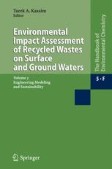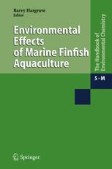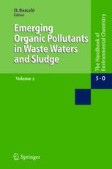Search
Search Results
-
Hazardous Organic Chemicals in Biosolids Recycled as Soil Amendments
The generation and disposal of biosolids produced at municipal wastewater treatment plants is a major environmental issue. Approximately 900 kg of...
-
Equilibrium Partitioning and Mass Transfer of Organic Chemicals Leached from Recycled Hazardous Waste Materials
Potentially hazardous waste materials (HWMs) are increasingly being recycled and used as highway construction and repair materials (CRMs). While...
-
Ecosystem Indicators of Water Quality Part II. Oxygen Production and Oxygen Demand
Seasonal transitions from oxygen production to oxygen demand at coastal aquaculture sites in southwestern New Brunswick (SWNB) can be defined in...
-
Lithium-Normalized Zinc and Copper Concentrations in Sediments as Measures of Trace Metal Enrichment due to Salmon Aquaculture
The results of metal analyses carried out on surficial sediment samples collected in the coastal waters of southwest New Brunswick and the...
-
Benthic Macrofaunal Changes Resulting from Finfish Mariculture
We present a review of the benthic macrofaunal changes that are circumstantially linked to intensive marine finfish aquaculture, or mariculture....
-
Organic Compounds in Paper Mill Wastewaters
This chapter is focused on the problem caused by the effluent discharges from paper and pulp mills. At present, three aspects should be considered in...
-
Nutrient, Oxygen and Carbon Ratios, CO2 Sequestrationand Anthropogenic Forcing in the Mediterranean Sea
The climate and the environment, together with present tectonic morphology, constitute main constraints for the Mediterranean Sea geochemistry. The...
-
River Inputs of Metals and Arsenic
This chapter deals with the inputs of dissolved heavy metals and arsenic by rivers to the Mediterranean Sea. It is divided into three parts. The...
-
Input of Various Chemicals Transported by Saharan Dust and Depositing atthe Sea Surface in the Mediterranean Sea
This paper reviews work on the role of Saharan dust as a contribution of various chemicals to the Mediterranean basin. Both the magnitude and the...
-
Mediterranean Sea and Humans: Improving a Conflictual Partnership
Intense human activities in regions surrounding enclosed and semi-enclosed seas such as the Mediterranean produce, in the long range, a strong...
-
The Mediterranean Mercury Anomaly, a Geochemical or a BiologocalIssue
This chapter deals with the distribution and speciation of mercury in the water column, sediment and biota of both the Western and Eastern Basins of...
-
Satellite Observations as Indicators of the Mediterranean Sea’s Health
Satellite observations of the marine environment allow the assessment of optical, thermal and structural properties, which can be inferred from the...
-
Chemistry and Fate of Organotin Antifouling Biocides in the Environment
Organotin antifouling paints are degraded relatively rapidly in seawater mainly by microorganisms, but they have high affinities to sediment and...
-
The São Francisco Estuary, Brazil
This is a first account of the physical and biogeochemical characteristics of the tropical São Francisco (SF) estuarine system, East Brazil,...
-
Toxicity and Preliminary Risk Assessment of Alternative Antifouling Biocides to Aquatic Organisms
Published literature has been reviewed regarding the toxicity of representative alternative antifouling biocides (Chlorothalonil, Dichlofluanid,...
-
Organic Enrichment at Cold Water Aquaculture Sites—the Case of Coastal Newfoundland
Benthic organic matter (OM) enrichment is a frequent environmental effect of coastal aquaculture. There is a need for simple, general methods of...
-
Environmental Management and the Use of Sentinel Species
To be successful, environmental management must be comprehensive and take into account the activities of all participants who share that...
-
Salmon Aquaculture, Nutrient Fluxes and Ecosystem Processes in Southwestern New Brunswick
Salmon aquaculture discharges organic wastes into the marine environment. Salmon metabolism and the waste discharges add nutrients and organic...
-
Recycling Solid Wastes as Road Construction Materials: An Environmentally Sustainable Approach
Improved environmental performance in industry and society is a concept now a quarter-century old. Efforts in this regard have yielded much in the...
-
Fragrance Materials in Wastewater Treatment
In recent years, there has been significant interest in understanding the input of fragrance materials (FMs) to aquatic ecosystems, and this has...
